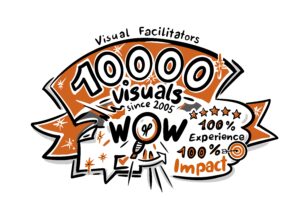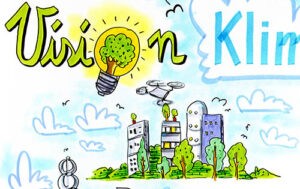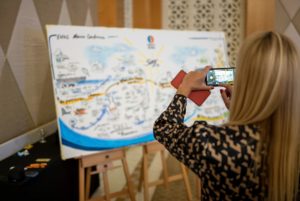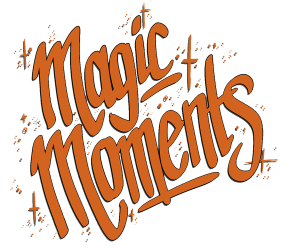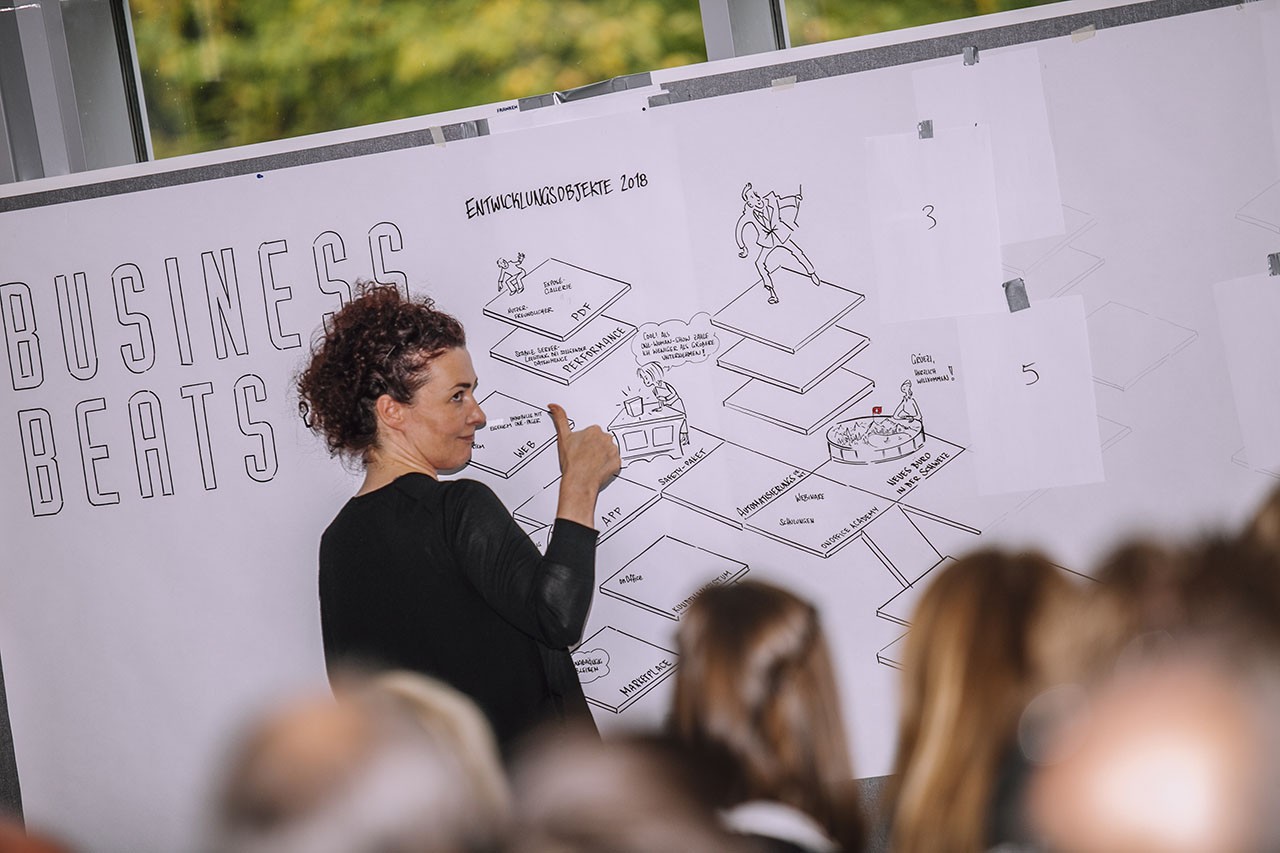
If you want to book a Graphic Recording and then make it a success, there are some points to consider. Your graphic recording booking requires know-how. Because even if it seems an easy task at first: Inquiring, comparing proposals, selecting, then on day X a service provider is available and the “picture” is ready?
It is not quite that simple. If you want to book a top graphic recorder and intend to get everything out of this asset, as well as have a real transformational benefit from the visual (and not just a “nice picture”), you should consider a few points.
First: There are numerous vendors on the market, multiple techniques, a wide range of delivered quality, and many other important factors to consider before booking your graphic recording. This article will summarize what to keep in mind. As one of the pioneers in the market since 2005 and one of the market leaders, we know what we are talking about: With our team, we deliver several hundreds of graphic recordings per year. In total, we can thus look back on the experience of over 10,000 graphic recording bookings. We have witnessed the development of almost two decades of the graphic recording market – and helped to shape it. This article on Graphic Recording bookings – as of 2023 — is the result of this wealth of experience: What follows will give you an overview of the purpose, advice what to look out for, booking tips and finally a checklist.
A Graphic Recording booking – why and for what?
Content
ToggleThe graphic recording method was originally developed for meetings. However, graphic recording applications have developed significantly. History and origin of Graphic Recording are well documented – for example here and here.
In terms of execution types of Graphic Recording, you can, on today’s market, find everything from process-oriented (as in the late 1970s) to very illustrative. So if you receive a handful of quotes, you may read “graphic recording” in all of them – but they certainly don’t speak of the same thing. In the best case, you are well informed, and know what you need and secondly what you’re getting.
Here’s an overview of possible use cases for your Graphic Recording booking:
Graphic Recording booking for meetings
This is what you can consider as the classic application. This is exactly what graphic recording was once invented for. Booking graphic recording for your meetings, strategy off-sites, board gatherings, ideation sessions, or anything dialog-oriented about some crucial topics falls into this application. Your meeting always needs a facilitator. A clear assignment of roles supports that the process design, the meeting agenda etc. make it onto your graphic recording in a well structured way. If your meeting doesn’t have a clear structure or if it is not led by a moderator (even better a facilitator), this will usually be visible on the recording.
Graphic Recording booking for Workshops
For internal business workshops, a graphic recording serves to make the process and the content and results visible to you and all participants, as well as to manifest the next steps. The visual summary of your workshop is just as important in real time on site (live minutes) as for a follow-up process and any further communication of your workshop results. This is suitable for almost all topics – and is often used for strategy, innovation, risk and crisis management (very relevant these days), team workshops, leadership training, workshops around vision and goals, mission statement development, etc.
What’s your benefit? With such a graphic recording booking your participants get deeper identification with content and results, which then get a better transfer into any follow-up activity. Not only that: the feeling of supportive, intensive teamwork also becomes visible and contributes to better results.
Graphic Recording booking for change projects
This use case of a graphic recording booking is again very close to the original, historical intent of graphic recording. Culture change, change management and change projects are among them. Here, two core success factors are an early involvement in your project’s process design, and a close collaboration between facilitator and visual practitioner.
Change does not happen overnight. Visuals created in a participatory way help people to more step into accepting change, to then co-create, and to later embody it. If visuals are part of your process from the very start, they also serve as bridges between the complexity and the often simple, but important, feelings of those involved.
As client, together with the facilitator, you’ll make sure that you have all participants of a change process “on board”, that no one goes “overboard”, so that everyone reaches the goal.
Graphic Recording booking for online courses and webinars
Even before the 2020 Zoom boom, many online course creators and webinar hosts were considering a graphic recording booking. Online trainings need to build connection. A graphic recording emerging in real-time creates such connection between content, questions, and what is learned. Solutions or answers to questions arising in a webinar or course can be visualized instantly when answered. A visual overview of the course content serves as mind map and knowledge visualization far beyond the actual online event.
Graphic Recording booking for conferences and lectures
Documenting keynotes and conferences using graphic recording live and in real-time is a more recent form that became very popular after 2011. So popular that some providers put that down as the definition of graphic recording – to mainly “draw lectures”. But graphic recording has always been more than that. You as a customer can have processes and meetings facilitated and documented with your graphic recording booking, as already mentioned above.
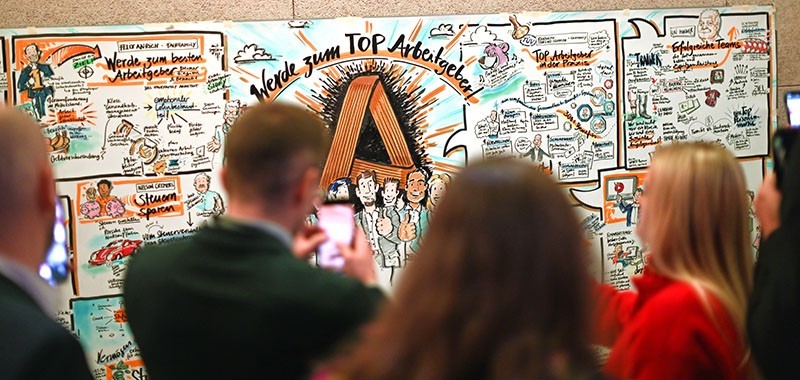
Graphic recording at conferences is the ideal way to create a high-quality documentation for your participants. There are many ways you can use the results. From social media posts, content creation, to using selected details in your post-event communication and much more.
Ideally, in arrangement with the graphic recorder, you should ensure that your visual is highly integrated into the event flow, so that your participants benefit directly from interacting with the live visualization. Best practice examples how you can successfully integrate graphic recording into conferences can be found here: A (German) article about the renowned Swiss Economic Forum, and a article about the SIETAR Forum, where the visualization was perfectly brought into interaction.
Graphic Recording booking for other events, e.g. shows or fairs
Of course, you can also have a graphic recording done at shows, trade fairs or other events. Whether and to what extent this makes sense depends on your individual situation. In any case, there are use cases that worked well: You can use graphic recording at trade shows to generate interaction, make your booth more attractive, support lead generation, or invite for dialogue. In this way, you can have an absolutely great conversation starter to generate lots of content in a more targeted manner.
Theoretically, you can also use a graphic recording at social or political events, even for weddings! Of course, this will be less about visualizing a process, but the entertainment factor (connecting people through visuals) creates a lasting impression.
The boundaries to so-called “event drawing” become fluid here, and with that the boundaries to illustration, which Graphic Recording in its original intent is not.
Graphic Recording booking – what to watch out for?
A note: An actual graphic recording booking checklist can be found at the end of this post. But keep on reading!
Intent:
- Graphic recording is a process-oriented method and should therefore be integrated into process, flow and intention of your event. The success factor: early involvement in the planning.
- The Graphic Recorder as a service provider is not a “nice-to-have” “add-on” but an essential part of the event and facilitator/moderation team in charge on site.
- Visualization contributes both as interactive contribution in the moment (as a real-time reflection surface on the group) and after your event (the graphic recording as documentation and “harvesting” of results).

Logistical:
- As a rule, a good task distribution makes sense: Your graphic recorder brings all material, you as event organizer on site provide all local logistics, as described below.
- If a digital graphic recording is booked – e.g. delivered via iPad or graphic tablet – your graphic recorder needs a table, power and beamer cables, possibly Internet, depending on the planning and the possibilities on site.
- If an analog graphic recording is booked – e.g. on paper or boards – your graphic recorder needs movable walls, a standing table and the right spot in the room.
- The right spot in the room: If it is a large group or a conference, your graphic recorder should be on the left or right side of the room. Neither at the back (he or she would have to turn his or her head 180 degrees to see stage or screen) nor at the very front (to avoid distractions and again for good visibility). The ideal location is to the left or right, ideally on the side where people go in and out. However, if it is a smaller group, the visual can be closely integrated into the actual circle of dialogue. In this way, the visual impacts the discussions and the course of event best, works “silently” but still interactively, and improves the group intelligence: For a better meeting result!
Content:
- A good graphic recorder prepares in detail. The most important thing: understanding the core intention of the event. If the graphic recorder only knows the event’s meaning and purpose, and the goal of the event, he or she can usually already do a good job. The essential questions to ask you as the organizer: Why does your event exist? Why do people come together? What do you want the outcome to be? Understanding the answers to these questions (without at all thinking of visuals) helps to create a graphic recording that supports exactly that intention and purpose of the event.
- Which makes it clear: a live visualization is a purpose-built tool to achieve something for you. That’s what it’s primarily about. And only secondarily, it’s about the “image”. You can support your graphic recorder by communicating content in advance as an event manager and client: If the graphic recorder already knows lectures, presentations, core content, etc., he or she can plan a layout and eye-tracking in advance. Ideally, the Graphic Recorder has experience in your industry, the challenge, and with the type of event.
- As a rule, Graphic Recorders are multi-talented individuals with above-average general education, as well as extensive client and project experience. Nevertheless, there are focal points. Therefore, good “matchmaking” is crucial for the success of your graphic recording. With our large team of experienced visualizers, we always make sure that you get exactly the right Graphic Recorder for your event.
After the event:
- The graphic recorder takes a high-resolution photo of the visualized image, retouches it and sends it to the organizer in a timely manner. High quality service providers make sure the following four points are respected: 1. top photo shots (RAW file formats), 2. good illumination/flash of the shot, 3. skilful post-processing of the file and 4. prompt delivery to the client.
- After the event, you as the client will receive customized recommendations on how to further use the finished graphic recording. Instead of giving standard recommendations, the Graphic Recorder incorporates what he or she has heard and witnessed on site.
- As a customer, in most cases you want to forward the graphic recording to your participants as soon as possible – as long as energy and mood are still flying high after the event. Then the impact is at its best. As the event organizer, it’s best to craft an email before the event and then just insert the image.
What else you should know:
- Whether the graphic recording takes place online (remote) or on-site should hardly matter. Process, technique, result and benefit are the same or similar, and many graphic recorders are proficient in both. Benefit of on-site work: Your participants get into conversation with the graphic recorder and witness the creation of the visual more directly.
Digital Graphic Recording booking
A good graphic recorder works analog (on paper) or digital (on iPads or graphics tablets) and makes a clear recommendation about what suits the client. Suits in order to achieve your goals – not because it’s their own preference.
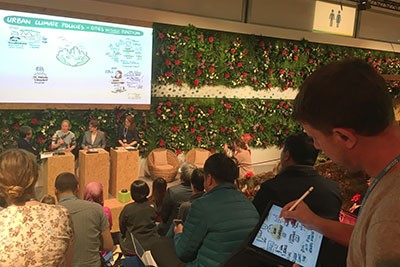
As a rule, and especially with larger groups, it is not advisable to have a digital graphic recording displayed (via beamer or on a screen) non-stop. That is how you avoid distraction. Here, precise timing and collaboration with the moderator/facilitator as well as superb management of any technology is essential.
Graphic Recording booking – find a service provider
There is a wealth of graphic recording service providers these days – that’s both good and bad news at the same time. With increasing awareness and expansion beyond its original purpose as process facilitation, numerous new providers have entered the market. Many of them come from the illustration field. Among them are highly regarded colleagues who do an excellent job. However, there are also graphic recorders with illustration background who don’t even know about the responsibilities of the graphic recorder role.
Here, if you want to use the method of graphic recording as a process-facilitation tool, you should take a careful look at the skills you are buying. So make sure you don’t just get a “pretty picture”, but use graphic recording to achieve your goals for your respective event. This should be exactly the focus of the service provider you book. Because every graphic recorder has the task of recording the process towards a goal in the best possible way, structuring it and visualizing it as big picture. And in doing so, to distinguish between the important and the unimportant, while at the same time depicting anything complex in a simplified and factual manner and integrating harvested discussion results and energies.
If you look at a layout, for example, this requires more than symbols and texts, but also information hierarchy, flow and viewer guidance for any stakeholders, possibly via a metaphor or a basic visual structure – in other words: an outstanding layout. If this is visible, it may be an indicator that your graphic recorder has prepared thoroughly.
Are there trained Graphic Recorders?
There is no official training for graphic recording. However, there are a few workshops offered by some pionieering providers in the industry. It is important to note that graphic recording cannot be learned in a one-day workshop. The few workshops mentioned are part of detailed curriculums and are usually several days long. They take place on-site, not online. Less than a handful of training providers in the world offer this.
Graphic recording has evolved in several waves since 1980, and few have learned directly from the founders of the method. Starting in the 2010s, there were many who started “self-taught graphic recording” – that means, they just started without any training.
People with the ability to listen well, pattern recognition, structure, focus, know-how in business processes and change, coupled with big picture understanding and the courage to apply “visual listening” quickly and pointedly have good prerequisites. Drawing well is not enough – as also emphasized by the founders of the graphic recording method.
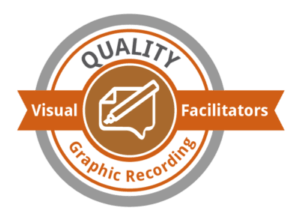
The visual practitioner association IFVP is currently preparing a professional certification of visualization disciplines. We at Visual Facilitators train our team again and again in internal advanced trainings. And we have learned directly from the founders of the method, which we are in close contact with.
Our clear recommendation to you as a client when booking a graphic recording: Take a close look at the service provider skills. No need to be an expert in your field or industry. The (German) book “CoCreate! – Das Visualisierungs-Buch” by our founder and CEO Mathias Weitbrecht contains a chapter on the skills of visual practitioners, to our knowledge still the most sophisticated literature on the topic.
Graphic Recording Booking – Prices
What does graphic recording cost? If you book visualization for an all-day meeting, for example, daily rates approaching those of management consultants are common. How did this happen? Graphic recording rates have, from day one (with the advent of the method in the late 1970s), been based on consulting day rates – means: the context from which graphic recording initially originated. In other words, prices have not historically been based on illustrator or artist fees (although this occasionally happens today).
The usual day rates are based on the fact that the graphic recording skillset and workload is enormous. A lot happens before putting down a marker on paper: Listening, pattern recognition, filtering of information, excellent general education, OD know-how, industry knowledge and much more. This is often underestimated. Good graphic recorders are literally like “consultants with markers in their hand”. Furthermore, the fees take into account a time-consuming preparation and a very demanding live situation.
For an industry-standard graphic recording daily rate, a range of € 1,000 to € 2,500 can be called. However, this approximate pricing excludes the following groups: Career starters who choose the path of working for free or particularly cheaply in order to gain experience; NGO clients who can often only pay significantly less, or also career changers who try to gain (seemingly) some competitive advantage.
The following points are also worth noting and are common in the industry when it comes to graphic recording fees:
- Travel and accommodation costs are not included but are usually charged on an expense basis against a copy of original bills.
- Half days usually cost way more than 50% of the daily rate. Charging by the hour is rather unusual, and booking only one hour of graphic recording usually makes little sense.
- Although you may be tempted to book graphic recorders purely on the basis of visual style, this is rarely advisable. Better book according to the service provider’s ability to contribute to an objective – for example, to achieve a specific meeting outcome.
- Image rights are unimportant to most graphic recorder service providers (as they consider their activity to be facilitation-related according to graphic recording history), others consider it important (as they may have an illustration background). In any case, they are always included in the fee.
 Price should not be the sole criteria. If you book graphic recording and you come across providers who sell you a solution instead of charging for their time – then you have reached the premium sector. Because only then it is really about a highly effective contribution to you reaching your goals. Then even a proposal (sent as PDF) is not really necessary, because there is nothing left to compare with other providers (which you can’t do anyway with i.e. three PDF quotes you receive).
Price should not be the sole criteria. If you book graphic recording and you come across providers who sell you a solution instead of charging for their time – then you have reached the premium sector. Because only then it is really about a highly effective contribution to you reaching your goals. Then even a proposal (sent as PDF) is not really necessary, because there is nothing left to compare with other providers (which you can’t do anyway with i.e. three PDF quotes you receive).
“Premium” here is not necessarily meant in terms of fees, but of the mindset, attitude and approach of the service provider. And if your graphic recording booking really helps you to achieve what you aim for, the result is a real win-win: Graphic recording in its full potential and purpose, and a full-on benefit for you as a client.
Graphic Recording Booking – the Blind Spot?
Graphic recording is always about contributing to what happens during a gathering of people that have a specific goal. If you wish to receive a visualization asset before a meeting, workshop, event or similar, in order to use it during the event, this is perfectly possible. It is just not a live graphic recording then, but a visualization created based on content and ideas you handed over “pre-event”.
And furthermore, your graphic recording is not a strategy visual or a target picture. This is true even if it reflects the results you may have achieved in a target image process. Your graphic recording would then display the path to your goal. The target visual itself should then be developed and visualized in a dedicated project (so-called strategic visualization). Especially since it addresses a different target group (namely mostly people who did not witness the process) and also pursues a different goal.
A graphic recording ends with the event or meeting. Since the participants are no longer together after the event, it is not common to make additions or do some rework. If someone changes the graphic recording at will afterwards, it loses its effect and is robbed of its task, namely to depict the real time process and exchange between people in the live situation.
After your Graphic Recorder Booking
Graphic recording booked – what now?
After booking, two parties go into the preparation: the booked service provider as well as you as the booking client.
The booked graphic recorder is faced with the challenge of being an external co-creative partner to dive into a content and context that is already clear to the clients (who are familiar in the subject matters). Therefore, it is your task as the client to brief the service provider in the best possible way: About content, agenda, any behind-the-scenes process, the intent of the event, the past, and future – the goal! What should be different after day X?
The briefing can take place several weeks before the event, but it is also good enough a few days before. The more graphic recording is integrated into the event design or, for example, a change process, the more important any preparation: interaction, role, collaboration with the facilitator or with open questions must be planned.
Before the actual event day, a graphic recording practitioner will prepare layout, flow and viewer guidance of the visual, and plan the “real estate” on the paper. Presentations (PPT) handed over in advance will help. Appropriate questions from your graphic recording service provider tell you: You are dealing with a professional that takes responsibility.
The graphic recording, which reflects processes and results (and often also the course of the day) of the event, can only be as good, content-rich, structured and lively as the event itself. Gaps in the content as well as in the facilitation in the room might definitely become visible in the picture delivered by a good graphic recorder. Inexperienced practitioners often try to iron out inconsistencies in the event format or content to make the visual look coherent. Here, our team members stand out because of a clear understanding of their role. A graphic recorder from Visual Facilitators bear gaps and can leave them standing. In this way, your graphic recording booking result makes the process visible just as it was.
Graphic Recording Booking – Your Success Factors
- Choose the right service provider for your event not based on visual style, but on experience.
- Mindset – understand what graphic recording really is, what it can and cannot do. Otherwise, it’s a nice add-on that we don’t recommend to anyone.
- Include the graphic recorder in the process early enough. This contributes to a good collaboration with high-quality results. Just book quickly for today for tomorrow? Such a a graphic recording is only advisable you have a long-term partnership. It is better to plan for next time with enough lead time.
- Involve the graphic recorder in their role in the event and announce him or her. At best, the introduction should take place at the very beginning of the event, for example during a welcome. Then the role is explained, people in the room know what that large paper wall on the wall is for, and can turn their focus back to speaker or facilitator.
- Allow time for a follow-up of the graphic recording. A de-briefing directly after the event gives both sides security in terms of content and gives you clues for the transfer into implementation or onward communication.
- For long-term use, a digitized and retouched result is necessary. Seek “pro” advice here, just because all post-event applications contribute to you reaching your goals just as much as the live creation.
Graphic Recording Booking – Checklist
- Is the Graphic Recorder member of a visualization industry association (e.g. IFVP)?
- What skills / previous experience / industry knowledge does the graphic recorder have?
- Book at least 2 weeks before the event, better much longer before.
- All key information of your scheduled event should be at hand: Agenda / timeline, venue / location, participants / target audience, event format digital or analog, role assignment (presenter or facilitator), and …
- … the goal. Does the graphic recorder know exactly what the event intents to do (independent of a visual)?
- Arrange a briefing call to discuss all content, logistical and technical details.
- Which corporate identity or logos should be taken into account?
- Are there any important “no go’s”, bounaries or “taboo topics” to be avoided?
- Who is the decision-making contact person on the day of the event for the graphic recorder (including contact details)?
- Who will introduce the visual service provider? Mention/name the role of the graphic recorder to attendees.
- Is the graphic recording woven into the agenda (whether online or analog)?
- Is the graphic recorder involved in the process? (E.g., include the visual result as the day progresses, or offer a meta-perspective presentation using the visual summary).
- Is everything ready for a digital graphic recording to be brought onto a screen or projector?
- Is there an optimal spot in the room for the analog graphic recording?
- Will the recording be photographed and retouched at the end of the event for your follow-up communication and development?
- Has a de-briefing call be scheduled, incl. pro-event recommendations?
Conclusion
Make sure you achieve your event goals with your graphic recording. It’s about much more than just booking a service provider. Especially more than “drawing” or a “pretty picture”. You can unleash tremendous power for your event goals with the right collaboration with a graphic recorder. Therefore, consistently align your graphic recording booking with the purpose of the event and book accordingly.
The abundance of providers on the market has its raison d’être. When writing this article, we at Visual Facilitators, with the experience of more than 10,000 graphic recording bookings delivered, held within us the intention to give orientation. So that you, as a client, can have a better overview of the wide spectrum of quality, service providers and approaches when booking a graphic recording. We wish all practitioning colleagues and all graphic recording bookings lots of success with this over 40 year old cultural language, visual and dialog support tool!

